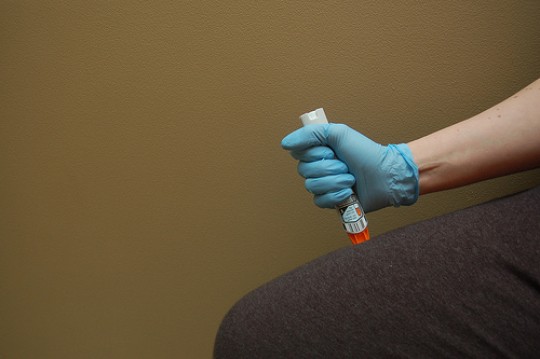For prolonged seizures, a quick shot often does the trick, study finds
For prolonged seizures, a quick shot often does the trick, study finds

For treating prolonged seizures outside a hospital setting, a quick intramuscular shot of anti-convulsant medication with an auto-injector, a kind of spring-loaded syringe, is as effective — if not more effective — than starting an intravenous line to administer the medicine directly to the bloodstream.
That’s according to findings from a first-of-its-kind study by researchers at Stanford and 16 other universities and hospitals nationwide. Their work appears in the New England Journal of Medicine.
The finding is important because giving a shot into the muscle of someone who is convulsing is generally safer and less time-consuming than starting an IV, said James Quinn, MD, a professor of emergency medicine here and a study investigator.
The intravenous route has always been considered the gold standard for treating status epilepticus in the field. But, as Quinn pointed out, “If patients are having a grand mal seizure, it can be tough to find a vein and get the medicine started, and it may increase the chance of a needle-stick injury either to the patient or medic.”
The aim of this study was to gather and compare data on the safety and efficacy of the shot, which administers midazolam, a sedative, versus the IV drip, which administers lorazepam, a similar sedative. As described in a National Institutes of Health release:
The study found that 73 percent of patients in the group receiving midazolam were seizure-free upon arrival at the hospital, compared to 63 percent of patients who received IV treatment with lorazepam. Patients treated with midazolam were also less likely to require hospitalization than those receiving IV lorazepam.
…
[The study] involved more than 79 hospitals, 33 emergency medical services agencies, more than 4,000 paramedics and 893 patients ranging in age from several months old to 103.
An interesting, behind-the-scenes aspect aspect of the research: Because they were the first responders, roughly 250 firefighter-paramedics in Santa Clara and San Mateo Counties had to be trained on how to conduct the clinical trial. “It required tremendous coordination,” Quinn told me. “For most of the firefighters, it was the first time they had done research. They did a great job, and I am proud of the job they and our research team did in this unique endeavor.”
By John Sanford
Stanford University Medical Center
Photo by gregfriese
###
* Stanford University Medical Center integrates research, medical education and patient care at its three institutions – Stanford University School of Medicine, Stanford Hospital & Clinics and Lucile Packard Children’s Hospital.
** The above story is adapted from materials provided by Stanford University School of Medicine
________________________________________________________________



















